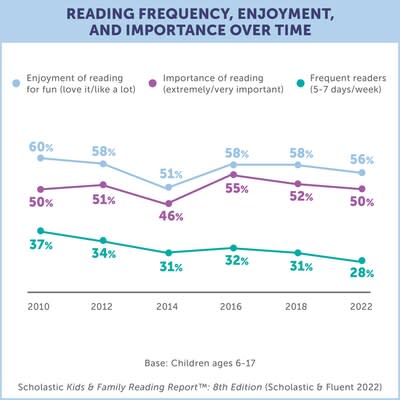New Data from the Scholastic Kids & Family Reading Report™ Finds Kids are Reading Less as They Age, with Adolescents the Most at Risk of Missing Out on the Benefits of Reading
Children's use of screens has risen sharply since 2018, with a significant increase among 6–11-year-olds participating in digital activities
Data highlights importance of access to books kids want and parent support
NEW YORK, Sept. 11, 2023 /PRNewswire/ -- Today, Scholastic (NASDAQ: SCHL), the global children's publishing, education and media company, released new data from the Kids & Family Reading Report™: 8th Edition, building on more than a decade's worth of research highlighting the views of both kids and parents on reading books for fun and the influences that impact kids' reading frequency. Notable findings from the data illustrate how kids' reading enjoyment, frequency, and perceived importance continue to decline with age, with marked declines by age 9 that do not rebound, in parallel with a stark rise in digital activities. This data is especially worrisome on the heels of the recent NAEP report card that shows a steep drop in reading scores, as well as the growing research on the mental health benefits of reading.
To learn more about the Scholastic Kids & Family Reading Report, visit www.scholastic.com/readingreport.
"The data is alarming – fewer children today identify as frequent readers, and reading frequency plummets as kids age. And yet, there's beauty in the data as it shows how access to books and a community of reading role models can bolster excitement for reading in a child's life, which in turn can ignite a greater interest in the skills of reading so that they can explore more stories," said Peter Warwick, Scholastic President and CEO. "With the best books that pique kids' interests and cultivate a joy for reading—a hallmark of our iconic Book Clubs and Fairs experiences—we can transform the nearly half of kids who are moderately frequent readers into frequent readers and set them on the path of a lifelong reading journey."
As survey findings revealed, the biggest predictors of reading frequency are the child's enjoyment of reading and belief in its importance, and being surrounded by reading role models including a parent who believes reading is important and provides books for their child. In a recent interview in The Washington Post, Sasha Quinton, President Scholastic School Reading Events, provides recommendations from personal experience on how parents can use the latest findings to encourage kids to bolster their reading habits and create bookjoy at home.
Among the top findings from the latest data:
Kids' reading enjoyment, frequency, and its perceived importance—including amongst parents—decline with the child's age.
There is a significant drop in reading enjoyment as kids age (70% among 6–8-year-olds vs. 46% among 12–17-year-olds).
Nearly half of 6–8-year-olds (46%) say they are frequent readers (reading books five or more days a week), this level declines to 32% of 9–11-year-olds, 21% of 12–14-year-olds, and 15% of 15–17-year-olds.
Half of school-aged children (50%) believe reading books for fun is highly important, however as children get older, they place less importance on reading for fun (64% children ages 6–8 vs. 43% children ages 12–17).
The vast majority of parents (83%) believe it's important that their child read books for fun, however, as children get older, parents are less likely to say reading is important (89% of parents of children ages 6–8 vs. 67% of parents of children 15–17).
Reading role models, particularly parents, are a strong predictor of a child's reading frequency.
In addition to child's enjoyment and value placed on reading, the biggest predictors of reading frequency are having a parent or guardian who believes reading is important and provides books for their child, and having people in the child's life that enjoy reading.
Ninety-five percent of children say that they have someone in their life who enjoys reading and six in ten (59%) say that a lot or nearly everyone in their life enjoys reading.
Children who are frequent readers are more likely than those who are infrequent readers (reading books less than once a week) to say that a lot or nearly everyone in their lives enjoys reading (80% of frequent readers vs. 26% of infrequent readers).
Parents want their children to read more books and have less screen time.
The majority of parents of 6–17-year-olds (82%) wish their children would read more books for fun, a marked increase from 73% of parents in 2018.
The majority of parents of 6–17-year-olds (86%) wish their child would do more things that did not involve screen time, an increase from 80% in 2018.
Children's digital activities have risen since 2018 among all age groups (6–17); of note, children ages 6–11 are increasingly participating in digital activities such as watching YouTube (81% in 2022 vs. 68% in 2018), going online for fun (53% in 2022 vs. 42% in 2018); play games or app on any electronic device (84% in 2022 vs. 76% in 2018); and go online for school (45% in 2022 vs. 34% in 2018).
The Scholastic Kids & Family Reading Report is a nationally representative survey sharing the views of both kids and their parents on reading books for fun and the influences that impact kids' reading frequency and attitudes toward reading. This 8th Edition survey was conducted by Fluent Research between December 13, 2022 and January 6, 2023, with a total sample size of 1,724 parents and children including 637 parents with children ages 0–5, 1,087 parents with children ages 6–17, plus one child ages 6–17 from the same household. Parents of children ages 6–17 completed their survey questions first before passing the survey on to one randomly selected child in the target age range. The survey sample was sourced and recruited by Ipsos using their nationally representative KnowledgePanel®.
For more information about Scholastic (NASDAQ: SCHL), visit the Company's media room: http://mediaroom.scholastic.com.


View original content to download multimedia:https://www.prnewswire.com/news-releases/new-data-from-the-scholastic-kids--family-reading-report-finds-kids-are-reading-less-as-they-age-with-adolescents-the-most-at-risk-of-missing-out-on-the-benefits-of-reading-301922664.html
SOURCE Scholastic Inc



